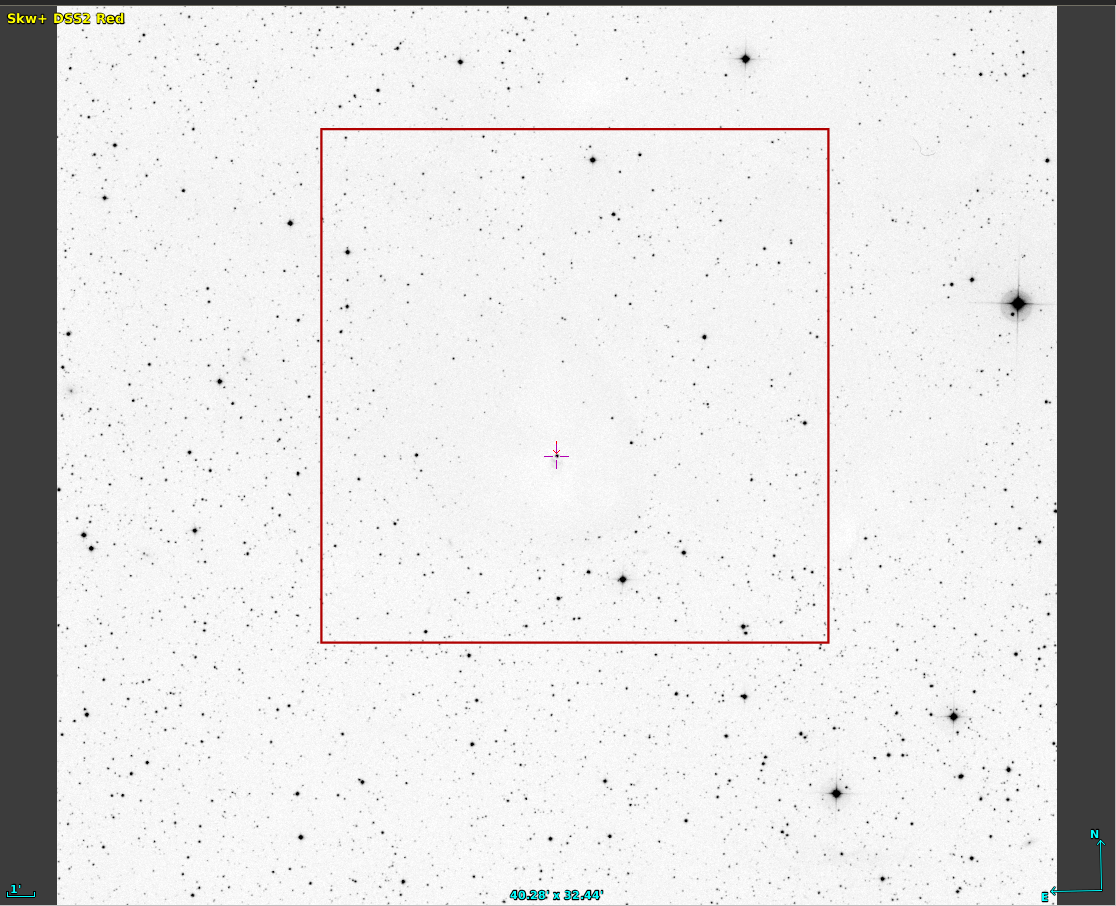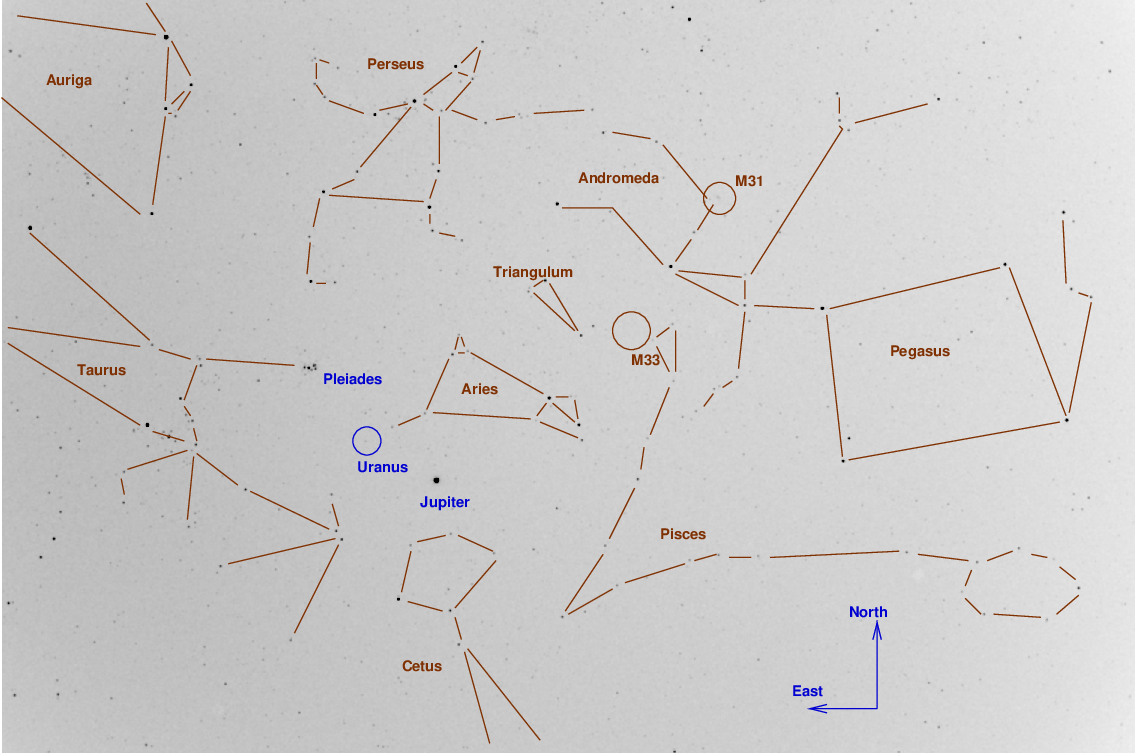
On the night of Sep 14/15, 2023, under very good conditions, I acquired images of V347 Aur as part of our optical monitoring program. All data was taken with the 12-inch telescope and ASI camera.
The variable is not only staying on its plateau - it has brightened a bit.
V347 Aur is a young stellar object (YSO) which undergoes semi-periodic outbursts. I'm part of a team of astronomers who have applied for (and received) time on the XMM-Newton X-ray telescope to study this object in the fall of 2023. We have organized an observing campaign with the AAVSO to monitor the object in the optical in order to determine when the outburst begins -- if it begins! Our prediction is some time in mid-August, 2023.
These observations involved:
Notes from the night:
The position of the variable star is
RA = 04:56:57.02 Dec = +51:30:50.9
At quiesence, it has magnitude V = 16-ish, but can rise to V = 12 in an outburst.
Here's a chart from the DSS2 Red plates, 0.6 degrees on a side.

The picture below, based on a stack of images taken on UT Jul 23, 2023, shows the area in the red box above. The variable is at its quiescent level in this image.

I've marked the location of several comparison stars.
star AAVSO ID B V ------------------------------------------------------ B 140 15.134 14.001 C 127 13.617 12.660 D 154 17.491 15.361 --------------------------------------------------------------------------
Here's a picture of the guider TV when pointed at the field (pointed slightly to the left of the variable, actually).

Tonight's stacks were formed from 23 x 60 sec in V band and 42 x 60 in B band. I used a photometric aperture of 5 pixels (6.0 arcsec).
I reported the following to AAVSO:
JD filter mag
---------------------------------------------------
2460202.82 V 14.49 +/- 0.06
2460202.85 B 15.47 +/- 0.28
---------------------------------------------------
The variable has brightened a bit in the past few days.

During the early morning hours, as the 12-inch telescope took its many pictures of V347 Aur, I took some pictures of the dark night sky with my Nikon Z6II camera and two different lenses
I set the camera to ISO 800 and placed it on a tripod for stability; I also used a cable release to trigger each exposure. The camera pointed nearly straight up in order to capture Andromeda -- M31 and M33 would provide a good test of the equipment and conditions. But the main goal was to figure out how good the PSF was near the edges and corner of the frame at f/5.6 and f/8.
I took images in RAW mode, the converted each NEF file into three separate FITS images using the nufraw software package. Note that this greatly increases the storage requirements:
1 NEF image 6064 x 4040 25 MB turns into 3 16-bit int FITS images
3 x 49 MB = 147 MB
The FITS images have suffixes _0000.fits, _0001.fits, _0002.fits, for the Red, Green, and Blue components of each RAW image, respectively. I focused on the Green images only for this analysis. In their original form, the images looked upside-down when displayed with the XVista "tv" command; in order to achieve the standard North-up, East-left orientation, I ran the XVista "flip" command like so:
flip DSC_1234.fits rows outfile=dsc_1234.fits
First, let's look at the 50mm images. Below is a chart showing the field of view; I modified one 10-sec exposure by using the XVista "smooth" program to blue the stars, making them larger and easier to see. The field of view is about 40 x 27 degrees.

The field is centered around Dec = +30 degrees. I checked for trailing in images of length 1, 5, 10 seconds. Only the 10-second images showed visible amounts of trailing.
I checked the PSF at the center of the image, in the north-western corner, and along the western edge. It was least good in the corner (no surprise), with a roughly 2-by-1 elongation at f/5.6; the PSF was better in the center and at the edge. Setting the aperture at f/8 helped a little bit, but not a lot.
1 sec f/5.6 lim mag 8.5 5 sec 9.0 - 9.5 10 sec 9.5 - 10.0
I could see faint traces of M33 in the 10-second images at f/5.6, but only hints of its presence in 5-second images.
Next, let's look at images taken with the zoom lens set to 18mm. The field is much larger: about 90 x 67 degrees.

I didn't see any significant trailing, even in the 10-second images.
This was a bit tricky, as it appeared that the images taken at f/5.6 weren't quite in focus. But the PSF at f/8 did look quite a bit nicer than that at f/5.6, so it might be a good idea to use this lens at f/8.
1 sec f/5.6 lim mag 6.0 5 sec 7.0 10 sec 7.5 - 8.0 1 sec f/8 lim mag 5.0 5 sec 6.0 - 6.5 10 sec 6.5 - 7.0
There was no trace of M33 in the f/8 10-second images, but I could start to see hints of it in the f/5.6 10-second images.
There was a considerable gradient across the frame in all images; this was probably a combination of light from the nearby streetlights, the general sky background due to bright business parking lots to the East, and the vignetting of the lens. Any wide-field images with this lens would benefit from some sort of flatfield correction.